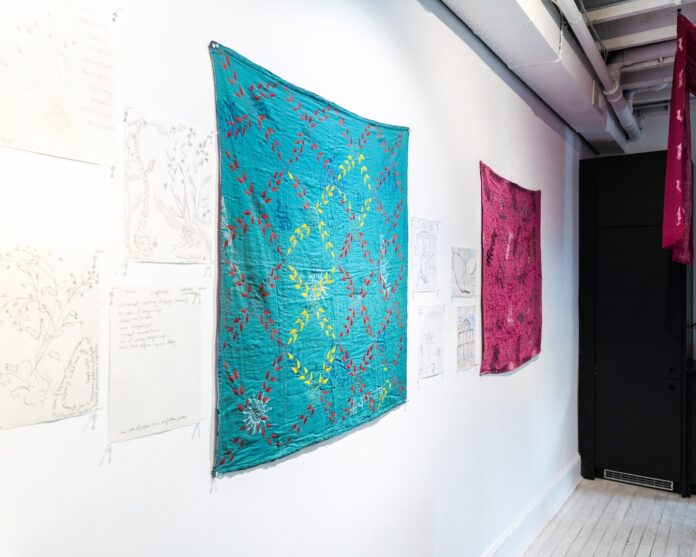Adjoining the rowhouse venue is a garden where Bose and her neighbors grow vegetables. This effort is documented by a video that plays near shallow silver bowls filled with rice and spices. Woodblock prints of trees and plants adorn the saris made in Bangladesh, a pair of which are draped across the ceilings of the two rooms that contain the show. (One of the rooms is, appropriately, a kitchen.) The D.C. artist also conducts poetry workshops, and excerpts from some of the resulting verses are printed or written, in Bengali or English, on the saris.
Bose has worked as an environmental lawyer, and climate change is her primary focus. Katakhali, once home to her late grandmother, sits precariously on an island in the Bay of Bengal that’s likely to be submerged by rising ocean levels.
Yet other concerns slip or smash their way into her work. Among the decorative wall hangings made from worn-out saris is one whose many images include a bloodied U.S. Capitol, a detail inspired by the Jan. 6, 2021, assault. Bose’s collective undertaking is traditional and even pastoral, but it’s driven by contemporary crisis. And there’s frequently a new one to weave into the fabric of life.
Another Nicholson Project gallery is a screening room for four short videos by Stephanie J. Williams, who specializes in stop-motion animation. The local artist’s “The Pleasure of Wasted Time” includes films in which beings that resemble half-dissected chickens dance to exuberant percussion scores. In close-ups, the dancers fray and decay, representing the stresses of living on society’s margins, and perhaps aging and mortality as well. Yet the creatures move robustly on their seemingly damaged feet.
Williams’s statement explains the show’s title by noting that “animating stop motion puppets is perhaps the most inefficient way to make my work. It demands my slowness.” The final results, however, are engagingly frisky.
An adjacent space exhibits some of the puppets the filmmaker animated, as well as props used to make the videos. Whether viewed before or after watching the animations, these artifacts testify to Williams’s skill. They don’t look like much, but when pressed into motion, they become fleshy, tactile and vital.
Monica Jahan Bose: Nourish: Storytelling With Saris and Stephanie J. Williams: The Pleasure of Wasted Time Through Nov. 4 at the Nicholson Project, 2310 Nicholson St. SE. thenicholsonproject.org.
Intricate details build into expansive compositions in the patterned abstractions of “Epicenter,” Pazo Fine Art’s first show at its new second location. The exhibition features the stylistically akin work of Baltimore painter Sue Crawford and two New York artists, Elise Ferguson and Richard Tinkler.
Crawford’s looping forms suggest natural phenomena, whether sound waves, sand dunes, or animal skins and shells. (Three of them are in a series titled “Testudo,” Latin for “tortoise.”) Dense and layered, the paintings are dominated by pinks and browns, with occasional interjections of blue. While the interlocking forms sometimes resemble the decorative motifs of textiles or pottery, they can also achieve the sweep of landscapes.
Ferguson’s forms are much more regular and geometric, and usually executed in a single color. Banks of parallel, closely spaced straight lines curve into rounded sections, giving an effect that appears almost typographical. The artist makes her designs with pigmented plaster on paper, and their apparent precision lessens upon close inspection: The lines are crisp, but their edges are rough. Ferguson sometimes adds accents in a second hue, but most often line and color register as aspects of the same implacable whole.
Whether employing ink, pencil or oil paint, Tinkler devises pictures of labyrinthine complexity. Most are drawings that have a kaleidoscopic symmetry, and all are painstakingly detailed. They’re doodles, but with an epic dimension. Most mesmerizing is the larger of the two paintings, a quiltlike canvas whose mainly pastel colors are punctuated by dashed red and orange lines. Like all the pieces in this show, it is tightly structured yet invitingly open.
Epicenter Through Nov. 2 at Pazo Fine Art, 1932 Ninth St. NW (entrance at 1917 9½ St. NW). pazofineart.com. 571-315-5279.
Little known in America, Gualtiero Passani established a formidable reputation in his native Italy during a career that began some 75 years ago. The paintings in Connersmith’s “Women,” billed as his first U.S. solo show, were made from 2005 to 2014, not that long before his 2019 death. But they appear out of time in two senses of that phrase: Their mode is that of mid-20th-century European painting, and their vitality suggests the work of a much younger person.
At first glance, Passani’s mostly nude subjects look to be merely objects. They are sometimes placed among vases, bowls or bottles, as if to equate one curved vessel with another. The artist rarely depicts faces and often cuts off bodies below their shoulders, leaving just torsos, legs and feet (the last usually encased in high-heeled shoes). Some of the women are silhouetted as single-color forms, notably in “Circus,” whose green central figure is the brightest thing in any of these mostly earth-toned pictures.
The artist’s style recalls Cubist-period Picasso and Matisse at his most stylized, yet these women are as fleshy as they are streamlined. Thighs bulge, skin sags, and at least one figure, placed at the rear of “Interior With Maternity,” is visibly pregnant. That Passani is looking with what feminist critics have called “the male gaze” is playfully acknowledged by “The Voyeur,” in which the face of an apparently pleased masculine observer edges into the composition. Yet Passani’s view is warm and empathetic, depicting women as iconic and yet unidealized. Even when lacking heads, they seem fully human.
Gualtiero Passani: Women Through Nov. 4 at Connersmith, 1013 O St. NW. connersmith.us.com. 202-588-8750.



